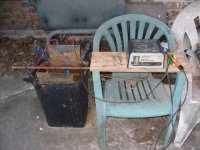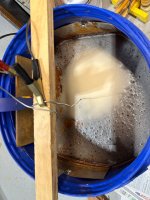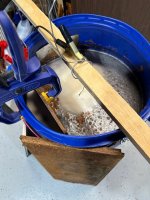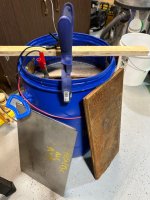Hi all. Long time lurker here, first time poster. I’ve been accumulating cast iron for close to a decade in order to keep some for personal use, maybe collect a few special pieces, and maybe to sell some. It piled up for years until last year when I restored a few pieces in a lye bath. A month or so ago I finally got around to putting together an e-tank. And that’s the source of most of my questions that I’m hoping someone can help me with.
I bought a 35-gallon plastic barrel, I had a manual battery charger that I picked up at a yard sale a couple years ago, and I bought some 6” x 24“ 16-ga. steel for anodes at Home Depot. I’ve done probably about five skillets so far, and the sheet steel is getting pretty honeycombed already, so it doesn’t produce very good current for very long even after cleaning with a wire brush on a drill. I went to a scrapyard the other day and bought some sheets of plate steel that are about a 1/4” thick and about 8” x 24”. Those should serve well for a while. I also ordered some graphite sheets online from Amazon, but I haven’t used them yet. I also bought some 1/4” plate of what was supposedly stainless steel at the same scrapyard, but it is not magnetic. So I’m not positive that they correctly ID’d it as stainless steel.
I’ve read a lot of posts about when to change the electrolyte— some say when it gets dirty and others say they almost never change it. I’m using sodium carbonate, a.k.a. washing soda. The water is very rusty looking, and I’ve periodically skimmed off as much crud as I can that’s suspended on the surface using a kitchen strainer. Does the condition of the water negatively affect the functioning of the anode at this early a stage?
I expect to periodically dispose of the electrolyte solution into the sanitary sewer system via flushing it down the toilet. But that’s my main concern with using stainless steel as an anode, if, in fact, I have stainless steel or can acquire some. And are there any concerns about the dissolved graphite in the solution and disposing it through the sanitary sewer system?
Thanks in advance for any responses to my questions and also for all of the helpful info here elsewhere.
I bought a 35-gallon plastic barrel, I had a manual battery charger that I picked up at a yard sale a couple years ago, and I bought some 6” x 24“ 16-ga. steel for anodes at Home Depot. I’ve done probably about five skillets so far, and the sheet steel is getting pretty honeycombed already, so it doesn’t produce very good current for very long even after cleaning with a wire brush on a drill. I went to a scrapyard the other day and bought some sheets of plate steel that are about a 1/4” thick and about 8” x 24”. Those should serve well for a while. I also ordered some graphite sheets online from Amazon, but I haven’t used them yet. I also bought some 1/4” plate of what was supposedly stainless steel at the same scrapyard, but it is not magnetic. So I’m not positive that they correctly ID’d it as stainless steel.
I’ve read a lot of posts about when to change the electrolyte— some say when it gets dirty and others say they almost never change it. I’m using sodium carbonate, a.k.a. washing soda. The water is very rusty looking, and I’ve periodically skimmed off as much crud as I can that’s suspended on the surface using a kitchen strainer. Does the condition of the water negatively affect the functioning of the anode at this early a stage?
I expect to periodically dispose of the electrolyte solution into the sanitary sewer system via flushing it down the toilet. But that’s my main concern with using stainless steel as an anode, if, in fact, I have stainless steel or can acquire some. And are there any concerns about the dissolved graphite in the solution and disposing it through the sanitary sewer system?
Thanks in advance for any responses to my questions and also for all of the helpful info here elsewhere.




